IT WAS SEEING the movie Kinsey that triggered a heated discussion about bisexuality between me and my girlfriend Meg, whom I had “accused” of being bisexual in light of her history of dating men several years earlier. She vehemently denied that this earlier life made her bisexual, giving rise to that age-old discussion of just what makes a person “bi”: Does it involve love or is it only about sex? Do serial partners of both sexes count, or do they have to be simultaneous? Are fantasies about sexual relations with both men and women sufficient, or does one have to act on both impulses? All the theories and stereotypes also came out in the course of our discussion: that bisexuals are sex fiends who’ll sleep with anything that moves; that they’re unable to commit to a sexual identity; that bisexuality doesn’t really exist but serves as a hedge for semi-closeted gay men and sexually adventuresome straight women. That last one reminded us of an old joke: “Bisexual men and bisexual women have one thing in common. They’ll both be having sex with men five years from now.”
Why is it so hard for us to wrap our minds around bisexuality? Our cultural struggle to conceptualize bisexuality stems in part from the freighted history of the term. When it first appeared in a dictionary in 1824, “bisexual” referred to people possessing the characteristics of both sexes, now referred to as “intersexuals” (or, popularly, as “hermaphrodites”). In the mid-1860’s, Karl Heinrich Ulrich postulated that men who have same-sex desires have female souls trapped inside male bodies. Subsequent sex researchers argued that people who desire their own sex have an inverted gender identity. From this sort of logic it was deduced that bisexuals are “psychosexual hermaphrodites.”
Freud upended the conversation on bisexuality beginning in the early 20th century when he used the term in the modern sense and hypothesized that all people are initially bisexual before a fixed, usually hetero-, sexual identity takes hold. Basing his theories upon contemporary ideas, later discredited, as to the biological bisexuality of the fetus, Freud hypothesized that everyone had a primary and innate bisexual disposition with respect to sex-object choice. But instead of arguing that bisexuality might be a normal manifestation of this inherent predisposition, Freud went on to spin an account of normal human development whereby same-sex desires are repressed or sublimated and heterosexual ones allowed to arise, relegating homosexuality and bisexuality to exceptional states that develop as the result of a series of psychological malfunctions.






